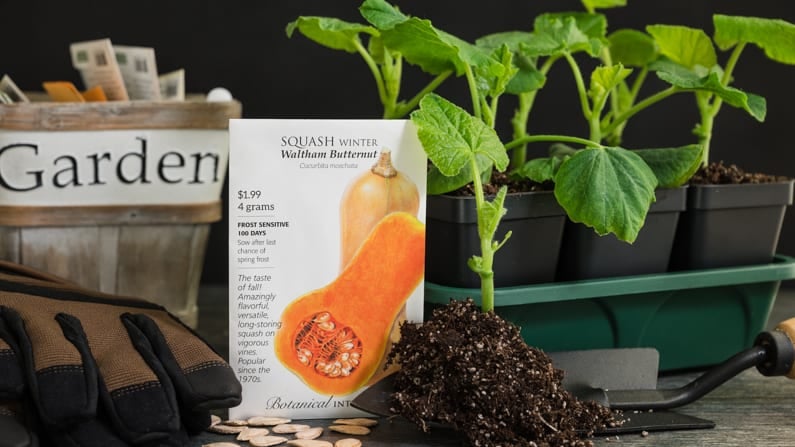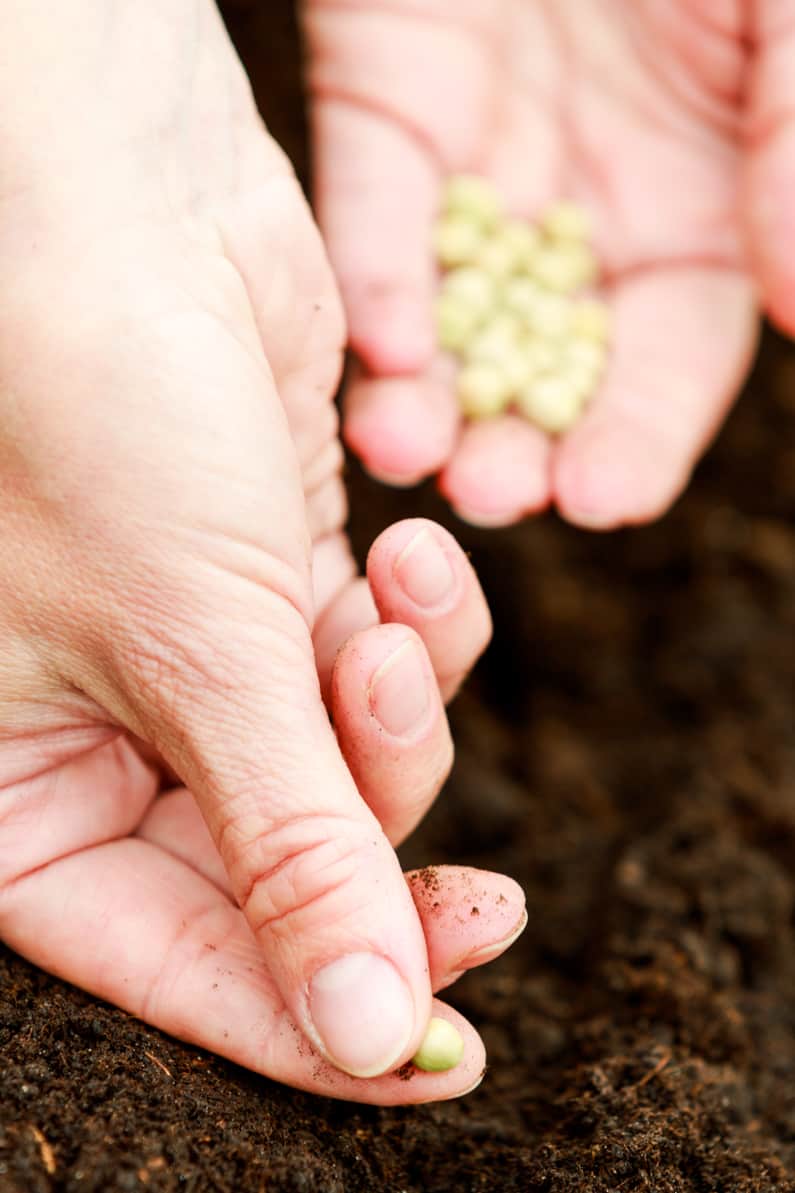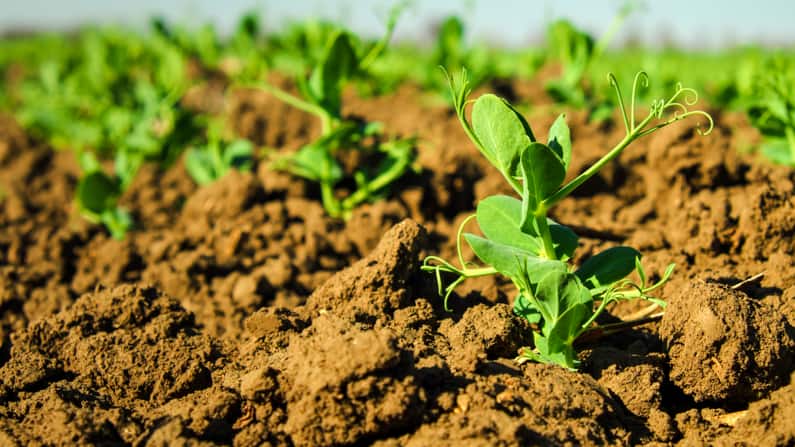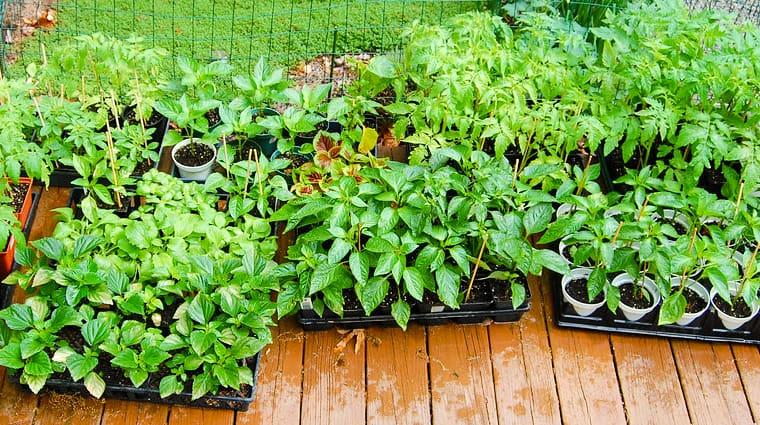Seedlings vs. Seeds: What’s Best for You to Plant and Why
INSIDE: Struggling to choose seedlings vs. seeds? This seed starting guide will help you decide which plants to grow from seed or plant as seedlings in your garden.
You thought you were ready to plan or plant your garden…
…but you’ve reached a fork in the road.
- Should you sow seeds?
- Or plan to pop some seedlings into the ground instead?
As with so many gardening dilemmas, there is no one right answer.
But there is a right answer for you and your garden…
Keep reading to discover which path you should follow.
What’s in this article about the difference between seeds and seedlings:
Heads up: I’ll earn a small commission if you buy something after clicking a link in this post. I only link to products I’d recommend to my best friend.

Growing from seed vs. seedlings
The difference between seeds and seedlings
All seedlings begin their lives as seeds. But the critical difference in deciding whether to purchase seeds or seedlings is how long it’ll take them to grow into a mature plant.
It all comes down to timing.
Do you have enough time to grow your plants from seed?
Some plants need to be started as transplants if you have a short growing season.
Tomatoes are the perfect example.
- You could buy tomato seedlings at a local nursery or start your own indoors.
- But most gardeners won’t be able to start these from seed outdoors and expect to harvest any tomatoes.
- Most of us need to start tomato seeds indoors 6-8 weeks before our last frost to get any tomatoes.
And some plants prefer to be direct-sown.
They want you to plant their seeds directly into your garden soil rather than transplant them as seedlings.
To plant seedlings, you must first have seedlings.
You can either grow your own or buy them.
Buying transplants is an easy way to get started with vegetable gardening. Just be sure to keep track of the varieties you like so you can grow them again.
If you want to grow your own, you’ll need to start them from seed indoors.
Related: Where to buy seeds for planting.
Pros and cons of starting plants from seed
Starting plants from seed can be rewarding, a test of your gardening abilities, and addictive.
Planting seeds is the best way to start a garden without breaking the bank. It’s also the perfect way to learn about the growing cycle of plants.
You can start seeds indoors or direct sow them.
No matter which way you plant them, there are pros and cons to growing from seed.
BONUS: As a bonus for joining my weekly newsletter, download a free Seed Viability Chart. Get expiration dates for more than 100 flower and vegetable seeds.

What are the benefits of growing plants from seed?
- Cost savings. Seeds are the least expensive way to plant your garden.
- Even an expensive packet of seed is usually cheaper than the cost of a single plant. So, it’s easy to grow multiples of the same plant – sometimes WAY too many!
- And most seeds will last for years, though over time, seeds become less viable.
- And if you grow open-pollinated varieties, you can save the seeds and regrow them every year – which means even more money saved!
- There are many varieties of plants, but nurseries only grow a few of them.
- When you start seeds, you’re not limited to the types that happen to be popular and easy for nurseries to sell.
- You can choose to grow that great-tasting heirloom tomato instead of the usual varieties you’ll find at your local nursery.
- When you grow plants from seed, you control how many you grow.
- Who needs a 4- or 6-pack of zucchini!?
- Most gardeners would agree that two zucchini plants are at least one too many in any vegetable garden.
- Growing some of your own food gives you the freedom to depend less on others for what you need. When you raise plants grown from seed, you’re taking that independence to the next level!
- It’s super satisfying to know you can grow vegetables from seed to plate and flowers from seed to vase.
Pros of growing from seed indoors:
- Starting seeds indoors gives you more control over the health of your seedlings.
- You can optimize conditions to produce the healthiest possible plants.
- Although it’s a small risk when you purchase plants, starting your own seeds also decreases the potential of introducing diseases, weeds, or pests into your garden.
Related: Set up this set of seed starting shelves in an afternoon.
- It allows you to grow the exact number of plants you need.
- Direct seeding outside in your garden can result in spotty germination.
- Difficult-to-control variables such as unfavorable temperatures, precipitation, or seed predation by birds, mammals, or insects can cause germination gaps.
- If you use season extenders, such as Wall o’ Waters, low tunnels, or a greenhouse, you can plant much sooner.
- This can make a big difference in areas where the growing season is short.
- And if you live in a warmer region, you can get your plants in the ground well before the summer heat starts to interfere with growth.
- Seeds germinate more reliably when you start them indoors.
- Because you control the environmental conditions (heat, wind, water), you can create the ideal situation for each seed and guarantee good germination every time.
- In your garden, seeds need to overcome the challenges of uneven planting depths, temperature fluctuations, and varying moisture levels.
- Seeds started indoors aren’t susceptible to predation from birds, insects, and other animals.
- Seeds started indoors under ideal conditions will also germinate faster.
- Since germination rates are better for seeds grown indoors, you can maximize every seed you have.
- Transplanted seedlings compete better with weeds than direct-sown seedlings.
- When you start seeds indoors, you can “garden” in a greenhouse, spare room, or even your basement when the weather is foul.
Free download: How long are seeds viable?
Pros of growing from seed outdoors:
- Direct sowing is simple.
- Direct sowing requires less planning than starting seeds indoors.
- No seedling care!
- Some plants don’t like to be transplanted and strongly favor direct sowing.

The disadvantages of growing plants from seeds
- There’s a learning curve when growing from seed. Some can be tricky (but most aren’t too tricky). The most common issues new seed starters run into are
- planting too deeply
- displacing the seeds when watering
- planting too many or too few
- and not providing enough light
- If you waste time waiting for seeds to germinate, you get weeks behind in your growing season. So, it pays to learn the proper way to start seeds.
- When you direct sow, you must spend time thinning. It’s essential.
- Some seeds need special treatments to germinate.
- For example, cold (stratification) or roughing up the seed coat (scarification).
- Make sure to treat seeds that need these treatments, or they most likely won’t germinate.
- Direct-sown seeds require more weeding than transplants – you don’t want the weeds to smother your tiny seedlings as they sprout in your garden.
- Direct-sowing is riskier since the seeds have to survive hazards such as drought, wind, pests, and weeds. To protect your seedlings, you may need to use floating row covers, scarecrows, and policing.
- It takes time to research the best seed varieties to grow in your garden. Make sure they’re a good match for your climate and the length of your growing season before you buy them.
- Seeds need to be planted at the right time. Make a note of when your seeds should be started before (or after) your last frost in the spring and before your first frost in the fall.
- To successfully start seeds indoors, you need to have a seed-starting station equipped with grow lights. Starting seeds in front of a window (even a south-facing one) will produce weak, leggy seedlings.
Make sure your seeds are still good: Download my FREE Seed Viablity Chart.
Pros and cons of planting seedlings
Why plant seedlings or transplants rather than seeds?
Planting seedlings can be more convenient, saves you time, and could be necessary, depending on where you live and how far you are into in the growing season.
All seedlings begin as seeds.
But you don’t have to plant transplants unless you want to because of the convenience factor or you have a short growing season and want to grow plants that need a head start indoors.

Benefits of starting a garden from seedlings
- Seedlings are the easiest way to jumpstart your garden because someone else babied the seedlings for you.
- Kids and other garden helpers usually find it easier to handle transplants.
- Local nurseries (not big box stores!) carry seedlings that’ll do well in your area. So you don’t have to worry about choosing the best varieties for your garden.
- Buying seedlings gives you more planting-time leeway. When it’s too late to grow some plants from seed, you can buy seedlings from a garden center and get them in the ground with no one the wiser.
- Seedlings are great for beginning gardeners who feel intimidated by taking care of vulnerable baby plants.
- Seedlings need less weeding than direct-sown seeds, especially when planted into mulch.
- Some pests love snacking on tiny sprouts. Because transplants are past that vulnerable stage when they go into the ground, they are more resistant to those pests.
- If you want to grow a garden with proper plant spacing, transplanting is the best way to make it happen. Improper spacing can occur due to gaps when sowing seeds and poor germination.

Disadvantages of planting seedlings
- Buying transplants is the most expensive way to plant a garden. And prices can vary drastically depending on where you shop.
- It’s more work to raise your own seedlings. Growing your own seedlings takes time.
- Transplants may not bounce back as quickly from stress as direct-sown plants.
- When you buy transplants, varieties are limited to the plants available locally or what you can order online.
Should I plant seeds or plants?
To help you decide whether to grow from seeds or seedlings, ask yourself these five questions.
- What’s my gardening budget?
Seeds are far cheaper than seedlings. If you plan to start seeds indoors, there’s an initial investment you need to make in seed-starting equipment. But after that, you’ll be able to grow your own plants for a fraction of the cost of buying them from a nursery. - How many of each plant do I need?
If you only need one or two, it makes sense to start them from seed if you can, rather than being stuck with a 6-pack of plants you can’t use. - Does this plant transplant well?
Some plants grow best when direct-seeded rather than planted as a seedling. - Is this a plant that’s easy to germinate from seed?
Some seeds are more difficult to germinate than others. For difficult-to-germinate seeds purchasing seedlings will ensure you can grow that plant. - How far into the season am I?
This is probably the most crucial question to answer. Timing is everything when it comes to growing from seed. If you start them too late, you may not get blooms or anything to harvest.
Is it worth growing plants from seed?
Growing plants from seed is definitely worth it! You’ll save a lot of money, gain a sense of achievement, and feel more connected with nature. The best thing about growing plants from seed is the options. You can grow many varieties you won’t find at your local nursery.
Your turn: Will you grow plants from seed or plant seedlings this year?
Or will you do some of both?
Share in a comment below!

